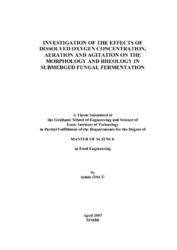Please use this identifier to cite or link to this item:
https://hdl.handle.net/11147/3632| Title: | Investigation of the Effects of Dissolved Oxygen Concentration, Aeration and Agitation on the Morphology and Rheology in Submerged Fungal Fermentation | Authors: | Öncü, Şelale | Advisors: | Ünlütürk, Sevcan | Publisher: | Izmir Institute of Technology | Abstract: | The effects of pH, agitation speed, dissolved oxygen tension (DOT) and aeration, significant in common fungal fermentations, on the production of polygalacturonase (PG) enzyme and their relation to morphology and broth rheology were investigated in a batch bioreactor using Aspergillus sojae which has no available literature report on the pectinase production. All four factors were effective on the response parameters under study. An uncontrolled pH increased biomass and PG activity by 27% and 38%, respectively compared to controlled pH (pH 6). pH did not significantly affect the broth rheology but created an impact on the pellet morphology. Similarly, the maximum biomass obtained at 500 rpm and at 30h was 3.27 and 3.67 times more than at 200 and 350 rpm, respectively. The maximum enzyme productivity of 0.149 U ml-1 h-1 was obtained at 200 rpm. Non . Newtonian and pseudoplastic broth rheology was observed at 500 rpm agitation speed. Furthermore, a DOT range of 30-50% was essential for maximum biomass formation, whereas only 10% DOT was required for maximum PG synthesis. Non . Newtonian shear thickening behavior (n>1.0) was depicted at DOT levels of 10% and 30%, whereas, non-Newtonian shear thinning behavior (n<1.0) was dominant at 50% DOT. When 2.5 l/min aeration experiment was investigated detaily; it was determined that at about 21st hour, polygalacturonase production approaches its maximum (1.49 U) and pellets are smaller, high in number. At 48th hour; polygalacturonase production declines to zero, biomass reaches its maximum and pellets are big (average pellet size is 1.94±0.58 mm) and fluffy with compact centers. At the end of fermentation (96.hour), fermentation medium is close to Newtonian. The overall fermentation duration (50-70h) was considerably shorter as opposed to common fungal fermentations revealing the economic feasibility of this particular process. As a result this study not only introduced a new strain with a potential of producing a highly commercially significant enzyme but also provided certain parameters significant in the design and mathematical modelling of fungal bioprocesses. | Description: | Thesis (Master)--Izmir Institute of Technology, Food Engineering, Izmir, 2007 Includes bibliographical references (leaves: 70-77) Text in English; Abstract: Turkish and English xi, 80 leaves |
URI: | http://hdl.handle.net/11147/3632 |
| Appears in Collections: | Master Degree / Yüksek Lisans Tezleri |
Files in This Item:
| File | Description | Size | Format | |
|---|---|---|---|---|
| t000642.pdf | MasterThesis | 2.02 MB | Adobe PDF |  View/Open |
CORE Recommender
Page view(s)
202
checked on Mar 31, 2025
Download(s)
80
checked on Mar 31, 2025
Google ScholarTM
Check
Items in GCRIS Repository are protected by copyright, with all rights reserved, unless otherwise indicated.